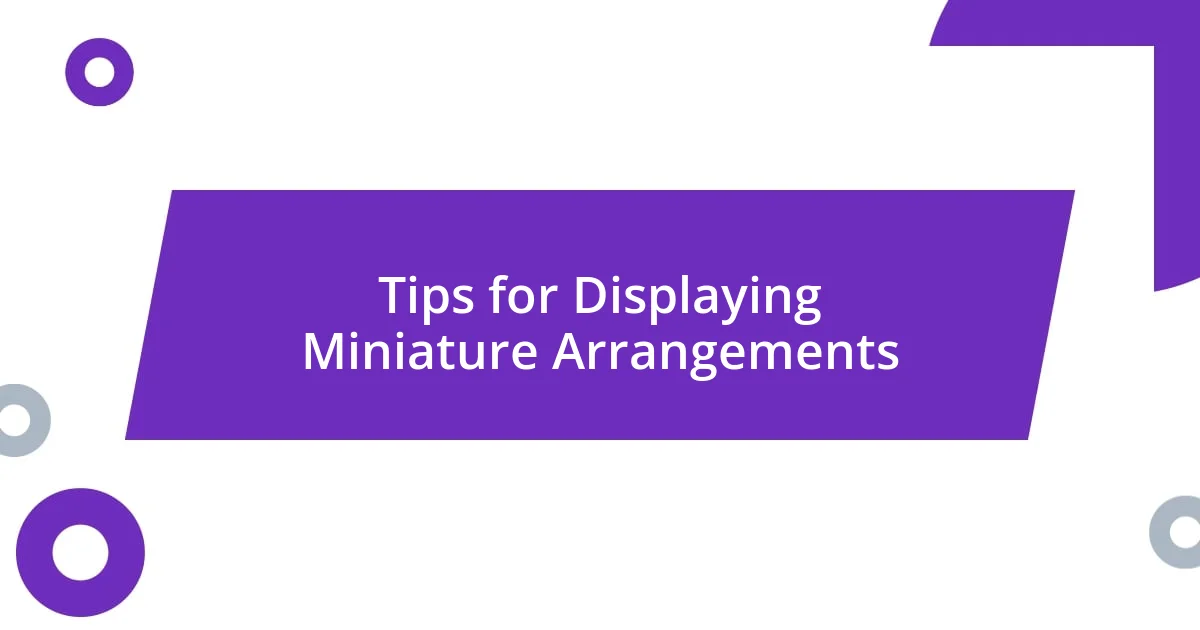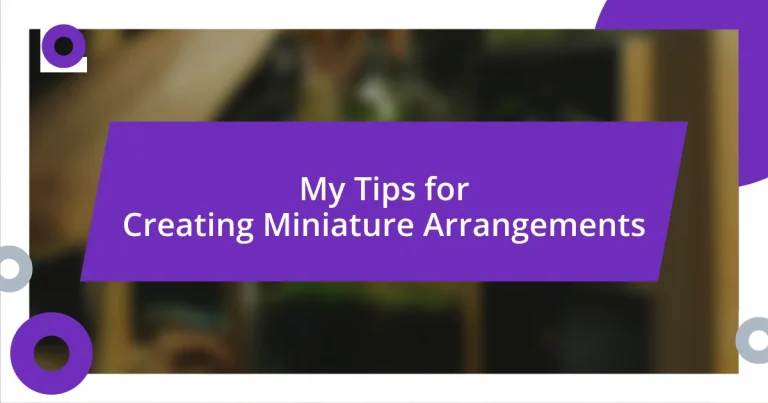Key takeaways:
- Miniature arrangements encapsulate nature’s beauty and evoke emotions by carefully selecting materials, plants, and storytelling elements.
- Choosing the right container is crucial for presentation, with options like glass terrariums or vintage tins enhancing the narrative of the arrangement.
- Techniques such as layering, defining focal points, and utilizing negative space create depth and cohesion, while regular maintenance and thoughtful displays enhance longevity and appeal.

Understanding Miniature Arrangements
Miniature arrangements are fascinating little worlds that encapsulate the beauty of nature in a compact form. I remember my first attempt at creating one; it felt like crafting a tiny masterpiece that could stir emotions just as much as a larger piece. They require not just skill but also a keen eye for balance and proportion, and I often find myself asking, “How can such small details convey such grand narratives?”
As I delved deeper into the art of miniature arrangements, I realized that the choice of materials is crucial. Each element, from the tiniest flower to the base, plays a significant role in telling a story. I still fondly recall the time I used a broken seashell as a focal point; it blew my mind how such a simple piece could evoke memories of beach vacations and sun-soaked afternoons. Don’t you think it’s incredible how a small object can hold so much meaning?
Understanding the essence of miniature arrangements is about more than just aesthetics; it’s about creating connections. These tiny creations often evoke nostalgia, making us reflect on moments and places that spark joy. Whenever I see a delicate arrangement, I can’t help but ponder, “What memories are wrapped within these miniature wonders?” It’s this blend of artistry and emotion that truly brings these arrangements to life.

Choosing the Right Containers
Choosing the right container for miniature arrangements can significantly impact their overall presentation. When I first began crafting these tiny displays, I leaned towards colorful ceramic pots to match my vibrant flowers. However, I quickly realized that a simple glass terrarium could accentuate the delicate details within, allowing the greenery and blooms to shine without competing for attention. It’s moments like these that remind me how crucial the right choice can be; it’s like finding the perfect frame for a beloved photograph.
Material is another key factor to consider. While ceramics and glass are popular, I’ve had delightful experiences using unconventional containers such as teacups or vintage tins. One particular arrangement in an old tea-tin brought a wave of nostalgia, reminding me of my grandmother’s kitchen filled with fragrant herbs. These unique containers can add character and elicit heartfelt stories, transforming a simple arrangement into an emotional keepsake.
Lastly, size and shape play a pivotal role in achieving balance. Sturdy, wide containers can ground tall arrangements, while smaller ones are perfect for delicate, compact displays. When I crafted a miniature forest scene inside a shallow bowl, I marveled at how the varied heights of the trees drew the eye deeper into the landscape. It’s these thoughtful choices that create a harmonious experience—both visually and emotionally.
| Container Type | Emotion/Aesthetic |
|---|---|
| Ceramic Pots | Colorful, vibrant feel |
| Glass Terrariums | Transparent, subtle elegance |
| Teacups | Nostalgic, vintage charm |
| Vintage Tins | Character, personal history |
| Shallow Bowls | Balanced, immersive landscape |

Selecting Suitable Plants and Flowers
Selecting suitable plants and flowers for your miniature arrangements is all about creating harmony in scale and color. In my experience, incorporating various textures and colors can elevate the overall impact. I once paired velvety soft succulents with vibrant, spiky blooms, and the combination created a striking visual contrast that surprised me. The key is to experiment; don’t hesitate to mix different plant types to discover unique pairings that resonate with you.
When choosing plants and flowers, keep these factors in mind:
- Size: Ensure the plants fit comfortably within your container without overcrowding.
- Color Palette: Select colors that complement one another and convey the mood you’re aiming for.
- Texture: Combine smooth leaves with rough-edged petals to add depth and interest.
- Seasonality: Use seasonal flowers for a fresh look, which can evoke specific emotions tied to times of the year.
- Longevity: Consider the lifespan of the greenery. I find that using hardy plants like air plants can help maintain your arrangement longer, reducing anxiety about wilting.
By thoughtfully selecting your plants and flowers, you transform your miniature arrangement into a captivating story that reflects your creativity and personal touch.

Tools for Miniature Arrangement
Creating miniature arrangements is like painting a small canvas, and having the right tools can enhance that creativity immensely. I’ve learned that precision tools, such as fine-tipped scissors and tweezers, are essential for delicate work. The first time I tried using regular scissors on tiny stems, I ended up with a mess! Tweezers helped me pick and position pieces with care, giving me more control over the final look. It’s in these moments of detail that true artistry shines.
When it comes to tools, a quality adhesive often makes all the difference, especially for securing elements in your arrangement. I remember struggling with a whimsical fairy garden I was crafting. I had used a product that left a shiny residue, ruining the natural look I aimed for. Switching to a clear-drying glue not only fixed my mishap but brought my tiny world to life, as everything blended seamlessly. What a relief it was to see my vision come together without those distractions!
Last but not least, a reliable workspace should never be overlooked. I’ve created my own little nook with a sturdy table, a good lamp for brightness, and an organized cart for my tools. This setup transforms my crafting time into an enjoyable ritual rather than a chaotic scramble. Think about your own workspace—does it inspire your creativity? I find that when my tools are within reach and my area is tidy, I can fully immerse myself in the joy of creating miniature arrangements.

Techniques for Arranging Miniatures
When arranging miniatures, one technique I highly value is the layering of elements. Imagine stacking different heights of plants or decorative pieces. For instance, I often place taller plants in the back and gradually introduce shorter ones in front. It’s like creating a stage where each element has its role, and I’ve found this approach not only adds depth but also invites the eye to explore the whole arrangement. Have you ever noticed how a well-structured scene can draw you in?
Another method that intrigues me is the principle of “focal point.” I remember crafting a mini garden where I decided to showcase a quirky little gnome. By directing attention to him, I discovered that the surrounding plants gained new meaning—they didn’t just fill space; they became part of a story. This strategy can enhance interest and create a cohesive narrative within your arrangement. It raises a question: what story do you want your miniature world to tell?
Utilizing negative space is another technique I’ve embraced in my designs. Initially, I piled everything together, thinking more was better. However, I learned that leaving some empty space allows the arrangement to breathe, making it more appealing and less cluttered. It’s amazing how a strategic gap can lead the viewer’s eye and create a sense of tranquility. Have you ever tried stepping back and appreciating the simplicity that space can bring to your composition? I find that it changes the whole perspective.

Maintaining Your Miniature Arrangement
Maintaining your miniature arrangement requires regular attention to keep it vibrant and appealing. I remember one time I neglected a tiny terrarium filled with succulents. As the weeks went by, I noticed the leaves losing their luster, and it hit me hard—these little plants needed more than just love; they thrived on care. Now, I make it a habit to check each arrangement weekly, ensuring they’re well-watered and dust-free.
Lighting plays a significant role in the longevity of your pieces, especially for those with live plants. I once placed a miniature arrangement too close to a window, and the intense sun scorched the delicate leaves. It was such a letdown to watch my creation wilt! I learned that indirect light works wonders—softening the rays can keep everything fresh and vibrant. Have you ever considered how lighting affects not just the mood of your space but the health of your arrangements?
Plus, cleaning your miniature arrangement is essential not just for aesthetics but also for overall health. I recall feeling a bit disheartened when I discovered dust building up on my carefully crafted display. It reminded me that even tiny worlds need upkeep! Using a soft brush or a gentle spray of water can do wonders. The sparkle it brings back is like reopening a book to discover new chapters—refreshing and inviting. Have you tried giving your pieces a little TLC? You’ll be amazed at how revitalizing it can feel!

Tips for Displaying Miniature Arrangements
The way you display miniature arrangements can truly elevate their appeal. I recall one particular time when I placed several tiny plants on a windowsill. The sunlight streamed in beautifully, and the arrangement looked alive with energy. That experience taught me that choosing the right backdrop—like a contrasting wall or a beautiful shelf—can make all the difference. Have you thought about how the background can highlight your mini creations rather than distract from them?
I’ve also discovered the importance of grouping items together in harmony. When I put three different miniature arrangements side by side, I felt there was an undeniable synergy between them. It was as if they were having a conversation! Varying heights, colors, and textures can create a dynamic display that draws people in. When was the last time you thought about how just the right grouping can transform the way someone experiences your space?
Finally, don’t underestimate the effect of seasonal themes on your display. I remember changing my miniature garden to reflect the seasons—tiny pumpkins in fall, snowmen in winter—and it completely refreshed the atmosphere. It’s such a gratifying process! Engaging with the changing times injects new life into your arrangement, capturing the essence of each season. How have you celebrated the seasons through your displays?














